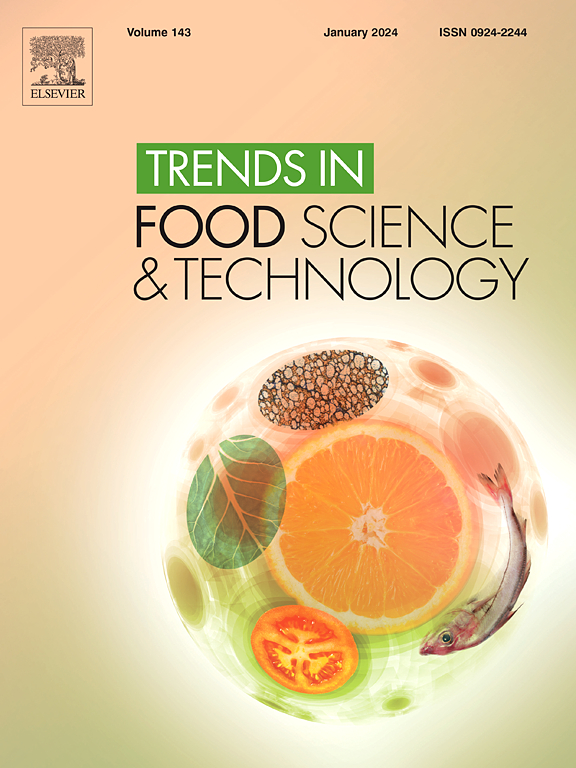能量饮料中常见的强效有机毒物添加剂:深入评述其对健康的影响、样品制备方法和色谱定量技术
IF 15.1
1区 农林科学
Q1 FOOD SCIENCE & TECHNOLOGY
引用次数: 0
摘要
目的对能量饮料中常见的强效有机毒物(pot)的大量摄入对健康的影响进行深入研究,并提出有效的样品制备和色谱定量方法来评估这些风险。数据来源本综述综合了非营养性含咖啡因饮料(nncd)的现有文献,重点关注ED和作为ED添加剂的各种锅,包括咖啡因、牛磺酸、甜味剂、防腐剂、合成着色剂和调味剂。研究选择与所讨论主题相关的研究是根据其对与EDs相关的健康风险的关注、分析这些饮料中有毒物质的方法以及样品制备和色谱定量技术的进展来选择的。数据提取:提取了与过度使用ED对健康影响相关的定性数据,特别是短期和长期风险,如心动过速、心血管问题和代谢紊乱。对各种样品制备技术(液相萃取、固相萃取和微萃取)和定量ED pot的色谱方法也进行了广泛的收集和详细的讨论。该综述详细介绍了各种样品制备方法,这些方法可以增强ED pot(目标分析物)的预浓缩,以及确保高效分离和高灵敏度的色谱技术。报告评估了创新绿色溶剂在环保萃取中的使用情况,并讨论了监测ed中常见添加剂罐的监管重要性,以符合世卫组织、粮农组织、FDA和欧洲食品安全局的安全标准。结论本文首次详细介绍了ED壶及其样品提取方法和色谱定量技术的健康风险。研究结果强调有必要对这些有毒物质进行监管,以减少健康风险并确保安全标准。并提出了提高ed和其他饮料中POT测定的最佳做法和未来的研究方向。本文章由计算机程序翻译,如有差异,请以英文原文为准。

Common additive potent organic toxicants in energy drinks: An in-depth review of their health impacts, sample preparation methods, and chromatographic quantification techniques
Objective
To provide an in-depth review of the health effects associated with the high intake of common additive potent organic toxicants (POTs) found in energy drinks (EDs) and to present effective sample preparation and chromatographic quantification methods for assessing these risks.
Data sources
The review synthesizes existing literature on non-nutritional caffeinated drinks (NNCDs), focusing on EDs and the presence of various POTs, including caffeine, taurine, sweeteners, preservatives, synthetic colourants, and flavourings, as ED additives.
Study selection
Studies relevant to the subject matter discussed were selected based on their focus on health risks associated with EDs, methods for analyzing toxicants in these drinks, and advancements in sample preparation and chromatographic quantification techniques.
Data extraction
Qualitative data related to the health effects of excessive ED consumption, particularly short-term and long-term risks such as tachycardia, cardiovascular issues, and metabolic disturbances, were extracted. Information on various sample preparation techniques (liquid-phase extraction, solid-phase extraction, and microextraction) and chromatographic methods for quantifying ED POTs were also extensively collected and discussed in detail.
Data synthesis
The review details various sample preparation methods that enhance the preconcentration of ED POTs (target analytes), alongside chromatographic techniques that ensure efficient separation and high sensitivity. It evaluates the use of innovative green solvents for eco-friendly extraction and also discusses the regulatory importance of monitoring common additive POTs in EDs to align with safety standards from WHO, FAO, FDA, and EFSA.
Conclusions
This is the first review detailing the health risks associated with ED POTs and their sample extraction methods and chromatographic quantification techniques. The findings emphasize the need to regulate these toxicants to reduce health risks and ensure safety standards. They also suggest best practices and future research directions for enhancing POT determination in EDs and other beverages.
求助全文
通过发布文献求助,成功后即可免费获取论文全文。
去求助
来源期刊

Trends in Food Science & Technology
工程技术-食品科技
CiteScore
32.50
自引率
2.60%
发文量
322
审稿时长
37 days
期刊介绍:
Trends in Food Science & Technology is a prestigious international journal that specializes in peer-reviewed articles covering the latest advancements in technology, food science, and human nutrition. It serves as a bridge between specialized primary journals and general trade magazines, providing readable and scientifically rigorous reviews and commentaries on current research developments and their potential applications in the food industry.
Unlike traditional journals, Trends in Food Science & Technology does not publish original research papers. Instead, it focuses on critical and comprehensive reviews to offer valuable insights for professionals in the field. By bringing together cutting-edge research and industry applications, this journal plays a vital role in disseminating knowledge and facilitating advancements in the food science and technology sector.
 求助内容:
求助内容: 应助结果提醒方式:
应助结果提醒方式:


